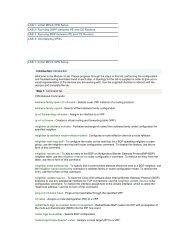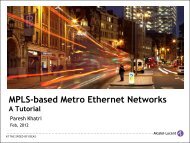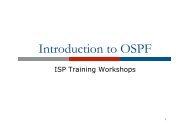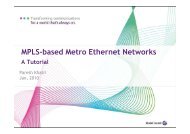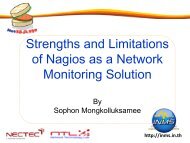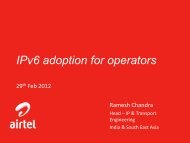Create successful ePaper yourself
Turn your PDF publications into a flip-book with our unique Google optimized e-Paper software.
IPv6 Security Threats and<br />
Mitigations<br />
Rohit Bothra (rbothra@cisco.com)<br />
Dilip Sai Chandar(dipasupu@cisco.com)<br />
Network Consulting Engineer, Cisco<br />
APRICOT Feb-March 2012<br />
© 2011 Cisco and/or its affiliates. All rights reserved. Cisco Public 1
Agenda<br />
• IPv6 Primer<br />
• Security Issues Shared by IPv4 and IPv6<br />
• Security Issues Specific to IPv6<br />
• Enforcing Security policies<br />
• Cisco IPv6 Products<br />
• Demo: IPv6 DoS attack<br />
• References<br />
© 2011 Cisco and/or its affiliates. All rights reserved. Cisco Public 2
© 2011 Cisco and/or its affiliates. All rights reserved. Cisco Public 3
Legend<br />
IPv4 and IPv6 Header Comparison<br />
IPv4 Header<br />
IPv6 Header<br />
Version<br />
IHL<br />
Type of<br />
Service<br />
Total Length<br />
Version<br />
Traffic<br />
Class<br />
Flow Label<br />
Identification<br />
Flags<br />
Fragment<br />
Offset<br />
Payload Length<br />
Next<br />
Header<br />
Hop Limit<br />
Time to Live<br />
Protocol<br />
Header Checksum<br />
Source Address<br />
Destination Address<br />
Source Address<br />
Options<br />
Padding<br />
Field’s Name Kept from IPv4 to IPv6<br />
Destination Address<br />
Fields Not Kept in IPv6<br />
Name and Position Changed in IPv6<br />
New Field in IPv6<br />
© 2011 Cisco and/or its affiliates. All rights reserved. Cisco Public 4
IPv6 Address Types<br />
• Three types of unicast address scopes<br />
Link-Local – Non routable exists on single layer 2 domain (FE80::/64)<br />
FE80:0000:0000:0000: xxxx:xxxx:xxxx:xxxx<br />
Unique-Local (ULA) – Routable with an administrative domain (FC00::/7)<br />
FC00:gggg:gggg: ssss: xxxx:xxxx:xxxx:xxxx<br />
Global – Routable across the Internet (2000::/3)<br />
2000:GGGG:GGGG:<br />
ssss: xxxx:xxxx:xxxx:xxxx<br />
• Interface ―expected‖ to have multiple addresses<br />
• Multicast addresses begin with FF00::/8<br />
FFfs:<br />
xxxx:xxxx:xxxx:xxxx:xxxx:xxxx:xxxx<br />
© 2011 Cisco and/or its affiliates. All rights reserved. Cisco Public 5
IPv6 Addresses – Unicast and Multicast<br />
Examples<br />
Router#sh ipv6 int Ethernet0<br />
Ethernet0 is up, line protocol is up<br />
IPv6 is enabled, link-local address is<br />
FE80::2D0:D3FF:FE81:9000<br />
Global unicast address(es):<br />
2001:DB8:12::1, subnet is 2001:DB8:12::/64<br />
Joined group address(es):<br />
FF02::1<br />
All nodes<br />
FF02::2<br />
FF02::5<br />
All routers<br />
FF02::D<br />
FF02::16<br />
OSPF Routers<br />
FF02::1:FF00:1<br />
FF02::1:FF81:9000<br />
All PIM Routers<br />
Link-Local<br />
Global<br />
All MLDv2 capable Routers<br />
© 2011 Cisco and/or its affiliates. All rights reserved. Cisco Public 6
ICMPv4 vs. ICMPv6<br />
Covers ICMP (v4) features: Error control, Administration, …<br />
Transports ND messages: NS, NA, RS, RA<br />
Transports MLD messages: Queries, Reports, …<br />
ICMP Message Type ICMPv4 ICMPv6<br />
Connectivity Checks X X<br />
Informational/Error Messaging X X<br />
Fragmentation Needed Notification X X<br />
Address Assignment<br />
X<br />
Address Resolution<br />
X<br />
Router Discovery<br />
X<br />
Multicast Group Management<br />
X<br />
© 2011 Cisco and/or its affiliates. All rights reserved. Cisco Public 7
• Layer2 remains unchanged<br />
• Layer4 (TCP, UDP..) and above unchanged<br />
• Same routing protocols: BGP, OSPF, RIP<br />
• Only Four major changes<br />
•Larger Addresses (128 bits compared to 32 bits)<br />
•Multiple addresses per host.<br />
•Fixed length header.<br />
•ARP is replaced with ND protocol.<br />
• But lot of security implications.<br />
© 2011 Cisco and/or its affiliates. All rights reserved. Cisco Public 8
© 2011 Cisco and/or its affiliates. All rights reserved. Cisco Public 9
Reconnaissance in IPv6<br />
• Default subnets in IPv6 have 2 64 addresses<br />
10 Mpps = more than 50 000 years<br />
• Public servers will still need to be DNS reachable<br />
• Administrators may adopt easy-to-remember addresses<br />
(::10,::20,::F00D, ::C5C0, :d09:f00d or simply IPv4 last octet for<br />
dual stack)<br />
• By compromising hosts in a network, an attacker can learn new<br />
addresses to scan<br />
• Transition techniques derive IPv6 address from IPv4 address<br />
© 2011 Cisco and/or its affiliates. All rights reserved. Cisco Public 10
Reconnaissance in IPv6?<br />
Easy with Multicast!<br />
• No need for reconnaissance anymore<br />
• 3 site-local multicast addresses<br />
FF05::2 all-routers, FF05::FB mDNSv6, FF05::1:3 all DHCP servers<br />
• Several link-local multicast addresses<br />
FF02::1 all nodes, FF02::2 all routers<br />
Source Destination Payload<br />
Attacker FF05::1:3<br />
DHCP Attack<br />
2001:db8:2::50<br />
2001:db8:1::60<br />
2001:db8:3::70<br />
http://www.iana.org/assignments/ipv6-multicast-addresses/<br />
© 2011 Cisco and/or its affiliates. All rights reserved. Cisco Public 11
Preventing Reconnaissance<br />
with IPv6 Multicast<br />
Organization B<br />
Organization A<br />
• The site-local/anycast addresses must be filtered at the<br />
border in order to make them unreachable from the<br />
outside<br />
• ACL block ingress/egress traffic to<br />
Block FEC0::/10 (deprecated site-local addresses)<br />
Permit mcast to FF02::/16 (link-local scope)<br />
Permit mcast to FF0E::/16 (global scope)<br />
Block all mcast<br />
ipv6 access-list NO_RECONNAISSANCE<br />
deny any fec0::/10<br />
permit any ff02::/16<br />
permit any ff0e::/16<br />
deny any ff00::/8<br />
permit any any<br />
© 2011 Cisco and/or its affiliates. All rights reserved. Cisco Public 12
Neighbor Discovery Issue#1<br />
Stateless Autoconfiguration<br />
Router Solicitations Are Sent by<br />
Booting Nodes to Request Router<br />
Advertisements for Stateless<br />
Address Auto-Configuring<br />
RA/RS w/o Any<br />
Authentication<br />
Gives Exactly Same<br />
Level of Security as<br />
ARP for IPv4 (None)<br />
Attack Tool:<br />
fake_router6<br />
1. RS<br />
2. RA<br />
Can Make Any<br />
IPv6 Address the<br />
Default Router<br />
2. RA<br />
1. RS:<br />
Src = ::<br />
Dst = All-Routers<br />
multicast Address<br />
ICMP Type = 133<br />
Data = Query: please send RA<br />
2. RA:<br />
Src = Router Link-local<br />
Address<br />
Dst = All-nodes multicast<br />
address<br />
ICMP Type = 134<br />
Data= options, prefix, lifetime,<br />
etc<br />
© 2011 Cisco and/or its affiliates. All rights reserved. Cisco Public 13
Neighbor Discovery Issue#2<br />
Neighbor Solicitation<br />
Security Mechanisms<br />
Built into Discovery<br />
Protocol = None<br />
A<br />
B<br />
=> Very similar to ARP<br />
Src = A<br />
Dst = Solicited-node multicast of B<br />
ICMP type = 135<br />
Data = link-layer address of A<br />
Query: what is your link address?<br />
Attack Tool:<br />
Parasite6<br />
Answer to all NS,<br />
Claiming to Be All<br />
Systems in the LAN...<br />
Src = B<br />
Dst = A<br />
ICMP type = 136<br />
Data = link-layer address of B<br />
A and B Can Now Exchange<br />
Packets on This Link<br />
© 2011 Cisco and/or its affiliates. All rights reserved. Cisco Public 14
Neighbor Discovery Issue#3<br />
Duplicate Address Detection<br />
Duplicate Address Detection (DAD) Uses neighbor<br />
solicitation to verify the existence of an address to be<br />
configured<br />
A<br />
Src = ::<br />
Dst = Solicited-node multicast of A<br />
ICMP type = 135<br />
Data = link-layer address of A<br />
Query = what is your link address?<br />
B<br />
From RFC 2462:<br />
« If a Duplicate @<br />
Is Discovered…<br />
the Address Cannot<br />
Be Assigned to the<br />
Interface»<br />
What If: Use MAC@<br />
of the Node You Want<br />
to DoS and Claim Its<br />
IPv6 @<br />
Attack Tool:<br />
Dos-new-ipv6<br />
© 2011 Cisco and/or its affiliates. All rights reserved. Cisco Public 15
Secure Neighbor Discovery (SEND)<br />
RFC 3971<br />
• Certification paths<br />
Anchored on trusted parties, expected to certify the authority<br />
of the routers on some prefixes<br />
• Cryptographically Generated Addresses (CGA)<br />
IPv6 addresses whose interface identifiers are<br />
cryptographically generated<br />
• RSA signature option<br />
Protect all messages relating to neighbor and<br />
router discovery<br />
• Timestamp and nonce options<br />
Prevent replay attacks<br />
© 2011 Cisco and/or its affiliates. All rights reserved. Cisco Public 16
ND threat Mitigation using SEND<br />
© 2011 Cisco and/or its affiliates. All rights reserved. Cisco Public 17
RA<br />
Protecting Against Rogue RA<br />
• Port ACL (see later) blocks all ICMPv6<br />
Router Advertisements from hosts<br />
interface FastEthernet3/13<br />
switchport mode access<br />
ipv6 traffic-filter ACCESS_PORT in<br />
access-group mode prefer port<br />
RA<br />
RA<br />
• RA-guard feature in host mode (12.2(33)SXI4<br />
& 12.2(54)SG ): also dropping all RA received<br />
on this port<br />
interface FastEthernet3/13<br />
switchport mode access<br />
ipv6 nd raguard<br />
access-group mode prefer port<br />
RA<br />
RA<br />
© 2011 Cisco and/or its affiliates. All rights reserved. Cisco Public 18
L3 Spoofing in IPv6<br />
uRPF Remains the Primary Tool for Protecting<br />
Against L3 Spoofing<br />
uRPF Loose Mode<br />
Spoofed IPv6<br />
Source Address<br />
ipv6 verify unicast source reachable-via any<br />
Access<br />
Layer<br />
X<br />
IPv6<br />
Intranet/Internet<br />
No Route to Src Addr prefix<br />
=> Drop<br />
uRPF Strict Mode<br />
ipv6 verify unicast source reachable-via rx<br />
Access<br />
Layer<br />
X<br />
IPv6<br />
Intranet/Internet<br />
Spoofed IPv6<br />
Source Address<br />
No Route to Src Addr prefix out the<br />
packet inbound interface => Drop<br />
© 2011 Cisco and/or its affiliates. All rights reserved. Cisco Public 19
DHCPv6 Threats<br />
• Note: use of DHCP is announced in Router<br />
Advertisements<br />
• Rogue devices on the network giving misleading<br />
information or consuming resources (DoS)<br />
Rogue DHCPv6 client and servers on the link-local multicast<br />
address (FF02::1:2): same threat as IPv4<br />
Rogue DHCPv6 servers on the site-local multicast address<br />
(FF05::1:3): new threat in IPv6<br />
• Scanning possible if leased addresses are<br />
consecutive<br />
© 2011 Cisco and/or its affiliates. All rights reserved. Cisco Public 20
DHCPv6 Threat Mitigation<br />
• Rogue clients and servers can be mitigated by<br />
using the authentication option in DHCPv6<br />
There are not many DHCPv6 client or server<br />
implementations using this today<br />
• Port ACL can block DHCPv6 traffic from client ports<br />
deny udp any eq 547 any eq 546<br />
© 2011 Cisco and/or its affiliates. All rights reserved. Cisco Public 21
• Sniffing<br />
IPv6 is no more or less likely to fall victim to a sniffing attack than IPv4<br />
• Application layer attacks<br />
The majority of vulnerabilities on the Internet today are at the application layer,<br />
something that IPSec will do nothing to prevent.<br />
• Rogue devices<br />
Rogue devices will be as easy to insert into an IPv6 network as in IPv4<br />
• Man-in-the-Middle Attacks (MITM)<br />
Without strong mutual authentication, any attacks utilizing MITM will have the<br />
same likelihood in IPv6 as in IPv4<br />
• Flooding<br />
Flooding attacks are identical between IPv4 and IPv6<br />
© 2011 Cisco and/or its affiliates. All rights reserved. Cisco Public 22
© 2011 Cisco and/or its affiliates. All rights reserved. Cisco Public 23
IPSec is not deployed as the IPv6 Security<br />
panacea<br />
• ―IPv6 has improved security as a result of its mandatory Ipsec<br />
support” -myth<br />
• IPsec already existed for IPv4<br />
• The mandatory-ness of IPsec for IPv6 is just words on paper.<br />
• There are problems with its deployment as a general end-to-end<br />
security mechanism.<br />
• Deployment of IPsec(v6) has similar problems as those of IPsec(4).<br />
As a result, IPsec(v6) is not deployed as a general end-to-end<br />
security mechanism.<br />
© 2011 Cisco and/or its affiliates. All rights reserved. Cisco Public 24
No IPv6 network = no problem ? Wrong !<br />
• IPv6 enabled by default on all modern OSes<br />
• Applications prefer IPv6 addresses<br />
• ―Blackhat‖ may not be malicious (Windows with ICS)<br />
• Time to think about deploying IPv6<br />
Inject RA<br />
IPv6<br />
I have IPv6 !<br />
Let’s use it !<br />
IPv4 Internet<br />
IPv4-only segment<br />
Client<br />
Dualstack<br />
Server<br />
© 2011 Cisco and/or its affiliates. All rights reserved. Cisco Public 25
Dual Stack with Enabled IPv6 by Default<br />
• Your host:<br />
IPv4 is protected by your favorite personal firewall...<br />
IPv6 is enabled by default (Win7, Linux, Mac OS/X, ...)<br />
• Your network:<br />
Does not run IPv6<br />
• Your assumption:<br />
I’m safe<br />
• Reality<br />
You are not safe<br />
Attacker sends Router Advertisements<br />
Your host configures silently to IPv6<br />
You are now under IPv6 attack<br />
• => Probably time to think about IPv6 in your network<br />
© 2011 Cisco and/or its affiliates. All rights reserved. Cisco Public 26
IPv6 Privacy Extensions (RFC 3041)<br />
/23<br />
/32 /48 /64<br />
2001<br />
Interface ID<br />
• Temporary addresses for IPv6 host client application,<br />
e.g. web browser<br />
Inhibit device/user tracking<br />
Random 64 bit interface ID, then run Duplicate Address Detection<br />
before using it. Rate of change based on local policy<br />
• supported in Windows and MacOS (choice isn't available to<br />
end user)<br />
Recommendation: Use Privacy Extensions for<br />
External Communication but not for Internal<br />
Networks (Troubleshooting and Attack Trace Back)<br />
© 2011 Cisco and/or its affiliates. All rights reserved. Cisco Public 27
IPv6 Header Manipulation<br />
• Unlimited size of header chain (spec-wise) can make<br />
filtering difficult<br />
• Potential DoS with poor IPv6 stack implementations<br />
More boundary conditions to exploit<br />
Can I overrun buffers with a lot of extension headers?<br />
Perfectly Valid IPv6 Packet<br />
According to the Sniffer<br />
Header Should Only Appear Once<br />
Destination Header Which Should<br />
Occur at Most Twice<br />
Destination Options Header Should<br />
Be the Last<br />
See also: http://www.cisco.com/en/US/technologies/tk648/tk872/technologies_white_paper0900aecd8054d37d.html<br />
© 2011 Cisco and/or its affiliates. All rights reserved. Cisco Public 28
Parsing the Extension Header Chain<br />
Fragmentation Matters!<br />
• Extension headers chain can be so large than it is fragmented!<br />
• Finding the layer 4 information is not trivial in IPv6<br />
Skip all known extension header<br />
Until either known layer 4 header found => SUCCESS<br />
Or unknown extension header/layer 4 header found... => FAILURE<br />
Or end of extension header => FAILURE<br />
IPv6 hdr HopByHop Routing Destination Destination Fragment1<br />
IPv6 hdr HopByHop Fragment2 TCP<br />
Data<br />
Layer 4 header is<br />
in 2 nd fragment<br />
© 2011 Cisco and/or its affiliates. All rights reserved. Cisco Public 29
Filtering Extension Headers<br />
• Determine what extension headers will be allowed<br />
through the access control device<br />
• IPv6 headers and optional extensions need to be<br />
scanned to access the upper layer protocols (UPL)<br />
• May require searching through several<br />
extensions headers<br />
• Known extension headers (HbH, AH, RH, MH,<br />
destination) are scanned until:<br />
Layer 4 header found<br />
Unknown extension header is found<br />
• Important: a router must be able to filter both option<br />
header and L4 at the same time<br />
© 2011 Cisco and/or its affiliates. All rights reserved. Cisco Public 30
© 2011 Cisco and/or its affiliates. All rights reserved. Cisco Public 31
Designing Security Policy<br />
© 2011 Cisco and/or its affiliates. All rights reserved. Cisco Public 32
Cisco IOS IPv6 ACL<br />
A Trivial Example<br />
Filtering inbound traffic to one specific destination<br />
address<br />
2001:db8:2c80:1000::1<br />
others<br />
ipv6 access-list MY_ACL<br />
remark basic anti-spoofing<br />
deny 2001:db8:2c80:1000::/64 any<br />
permit any 2001:db8:2c80:1000::1/128<br />
interface Serial 0<br />
ipv6 traffic-filter MY_ACL in<br />
Serial 0<br />
IPv6 Internet<br />
Prefix: 2001:db8:2c80:1000::/64<br />
© 2011 Cisco and/or its affiliates. All rights reserved. Cisco Public 33
CoPP: Control Plane Policing<br />
• A router can be logically divided into three functional<br />
components or planes:<br />
1. Data plane—packets going through the router<br />
2. Control plane—routing protocols gluing the network<br />
together<br />
3. Management plane—tools and protocols used<br />
to manage the device<br />
• Route Processor contains control and management planes<br />
© 2011 Cisco and/or its affiliates. All rights reserved. Cisco Public 34
Problem Definition<br />
• Network uptime is increasingly becoming more vital to<br />
companies.<br />
• Denial of Service (DoS) attacks are just one example of<br />
a network assault on the control plane.<br />
• DoS attacks target the network infrastructure by<br />
generating IP traffic streams to the control plane at very<br />
high rates.<br />
• A DoS attack targeting a Route Processor (RP) can<br />
cause high Route Processor CPU utilization.<br />
© 2011 Cisco and/or its affiliates. All rights reserved. Cisco Public 35
Solution - Control Plane Policing<br />
• Protects the Control Plane from DoS attacks<br />
• Uses QoS to identify and rate limit traffic.<br />
• Allows specification of types of packets (traffic-classes) & the<br />
desired rate to be sent to CPU.<br />
• CPU cycles are used only for packets matching the criteria,<br />
availability of the network is greatly increased.<br />
• Control plane treated as a separate entity<br />
• CoPP protects control / management planes:<br />
1. Ensures routing stability<br />
2. Reachability<br />
3. Packet delivery<br />
4. CP policies are separate from DP and don’t impact data plane.<br />
© 2011 Cisco and/or its affiliates. All rights reserved. Cisco Public 36
Which packets are we talking about?<br />
• CPU bound packets that will be policed :<br />
- L2 Fwd Packets (ARP, IPX, Broadcast, etc)<br />
- L2 Control: Keepalives and control packets for HDLC, PPP,<br />
FR LMI, ATM control ILMI, X.25 and ISDN call setup, STP<br />
BPDUs<br />
- L3 Control: Routing protocol control packets<br />
- L3 Fwd Packets (telnet, SNMP, HTTP, ICMP, etc)<br />
- Control Packet (BPDU, CDP, IGMP, DHCP, etc)<br />
- L3 and L2 Miscellaneous:<br />
© 2011 Cisco and/or its affiliates. All rights reserved. Cisco Public 37
Configuring CoPP<br />
• 4 step process:<br />
1. Enable global QoS<br />
2. Classify the traffic<br />
3. Define the QoS policy<br />
4. Apply the policy to control plane ―interface‖<br />
© 2011 Cisco and/or its affiliates. All rights reserved. Cisco Public 38
Sample Traffic Classification<br />
1. Critical Traffic—routing protocols, control plane no rate-limit<br />
2. Important Traffic—SNMP, SSH, AAA, NTP, management<br />
plane, maybe rate-limit<br />
3. Normal Traffic—other expected non-malicious traffic, ping<br />
and other ICMP, rate-limit<br />
4. Undesirable—handling of potentially malicious traffic we<br />
expect to see, fragments and the like, drop this traffic<br />
5. Default—non-IP traffic or any other non identified IP traffic,<br />
maybe rate-limit<br />
© 2011 Cisco and/or its affiliates. All rights reserved. Cisco Public 39
© 2011 Cisco and/or its affiliates. All rights reserved. Cisco Public 40
Cisco IOS 12.0S<br />
Cisco 12000 Series Routers<br />
Cisco 10720 Series<br />
Cisco IOS 12.4/12.4T<br />
Cisco 800 Series Routers<br />
Cisco 1700 Series Routers<br />
Cisco 1800 Series Routers<br />
Cisco 2600 Series Routers<br />
Cisco 2800 Series Routers<br />
Cisco 3600 Series Routers<br />
Cisco 3700 Series Routers<br />
Cisco 3800 Series Routers<br />
Cisco 7200 Series Routers<br />
Cisco 7301 Series Routers<br />
Cisco 7500 Series Routers (EoL)<br />
Cisco IOS-XR<br />
CRS-1, Cisco 12000<br />
Cisco IOS 12.2S family<br />
Cisco ASR1000 series<br />
Cisco 72/7300 Series Routers<br />
Cisco 75/7600 Series Routers<br />
Cisco 10000 Series Routers<br />
Catalyst 3750/3560/2960 Series<br />
Catalyst 4500 Series<br />
Catalyst 6500 Series<br />
Cisco Product Portfolio<br />
ASA Firewall (7.x), FWSM 3.1,<br />
LMS 2.5, CNR 6.2, NFC 5.x, NAM<br />
3.x,<br />
MDS9500 series, GGSN 7.0<br />
Nexus 7000<br />
© 2011 Cisco and/or its affiliates. All rights reserved. Cisco Public 41
Key Take Away<br />
• So, nothing much new in IPv6<br />
Reconnaissance: address enumeration replaced by DNS<br />
enumeration<br />
Spoofing & bogons: uRPF is our IP-agnostic friend<br />
NDP spoofing: RA guard and more feature coming<br />
ICMPv6 firewalls need to change policy to allow NDP<br />
Extension headers: firewall & ACL can process them<br />
Amplification attacks by multicast mostly impossible<br />
• Lack of operation experience may hinder security for a<br />
while: training is required<br />
• Security enforcement is possible<br />
Control your IPv6 traffic as you do for IPv4<br />
• Leverage IPsec to secure IPv6 wherever suitable<br />
© 2011 Cisco and/or its affiliates. All rights reserved. Cisco Public 42
Summary: Key take away<br />
© 2011 Cisco and/or its affiliates. All rights reserved. Cisco Public 43
Summary: Key take away<br />
© 2011 Cisco and/or its affiliates. All rights reserved. Cisco Public 44
Reference & Recommended Reading<br />
www.cisco.com/go/ipv6<br />
Source: Cisco Press<br />
© 2011 Cisco and/or its affiliates. All rights reserved. Cisco Public 45
Demo: DoS Attack<br />
Attack Type: MLDv2<br />
Solution Applied: CoPP<br />
© 2011 Cisco and/or its affiliates. All rights reserved. Cisco Public 46
Thank you.<br />
© 2011 Cisco and/or its affiliates. All rights reserved. Cisco Public 47




